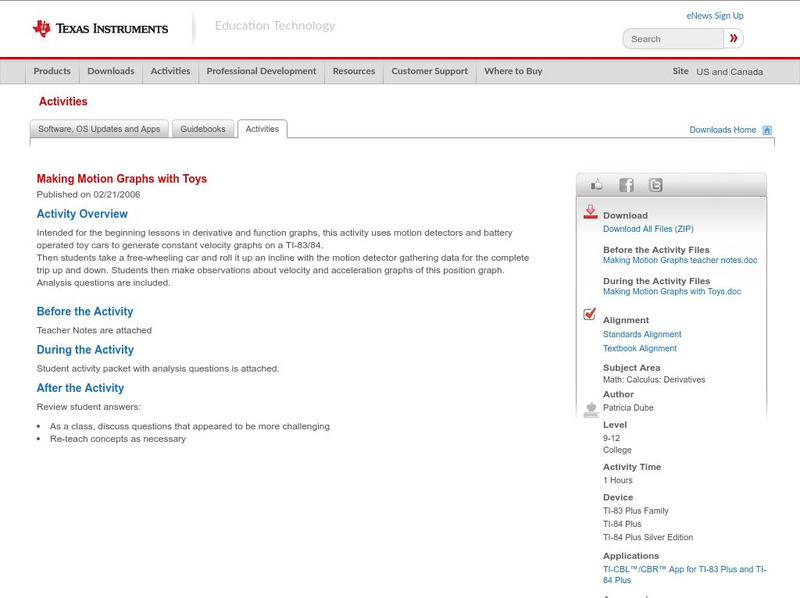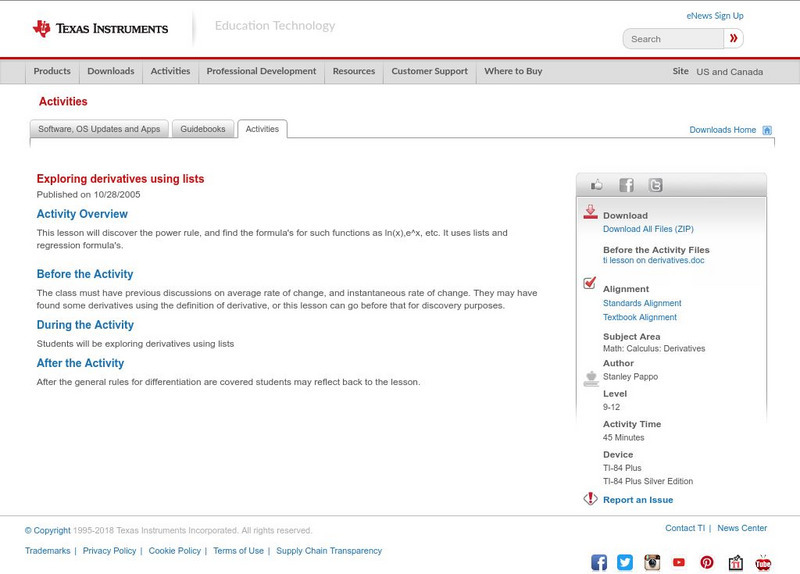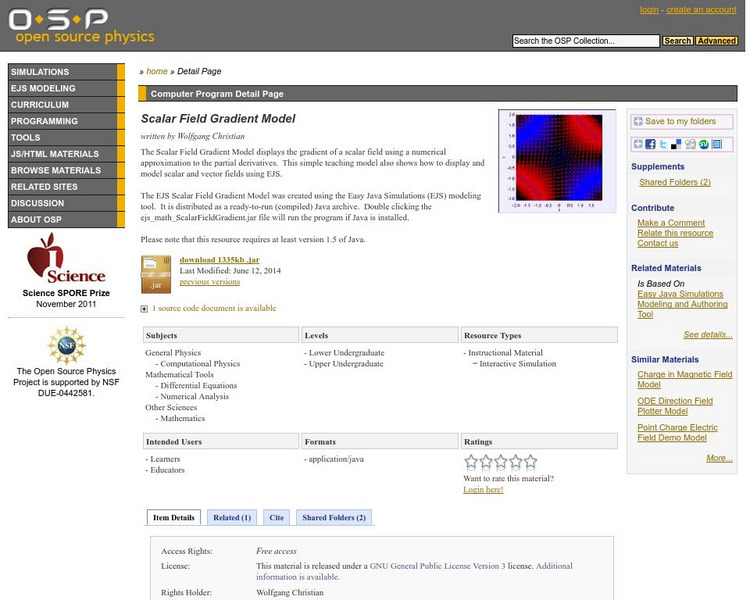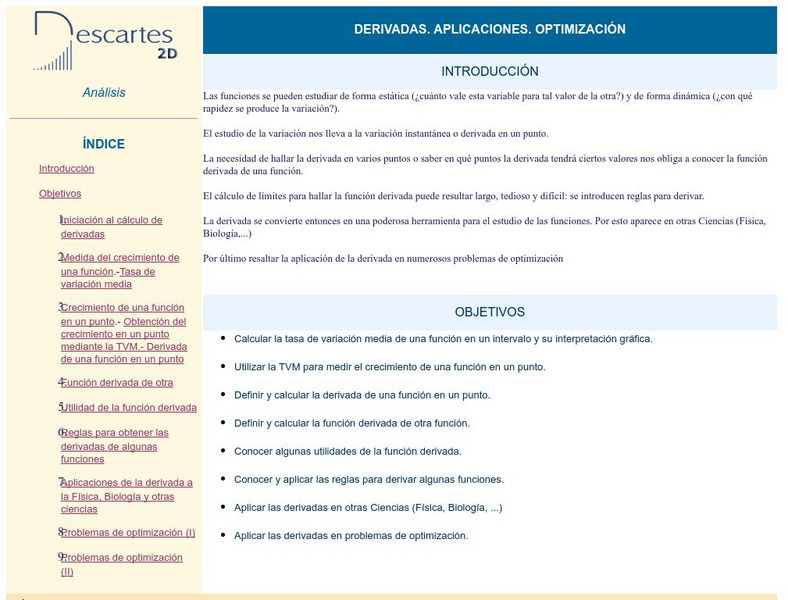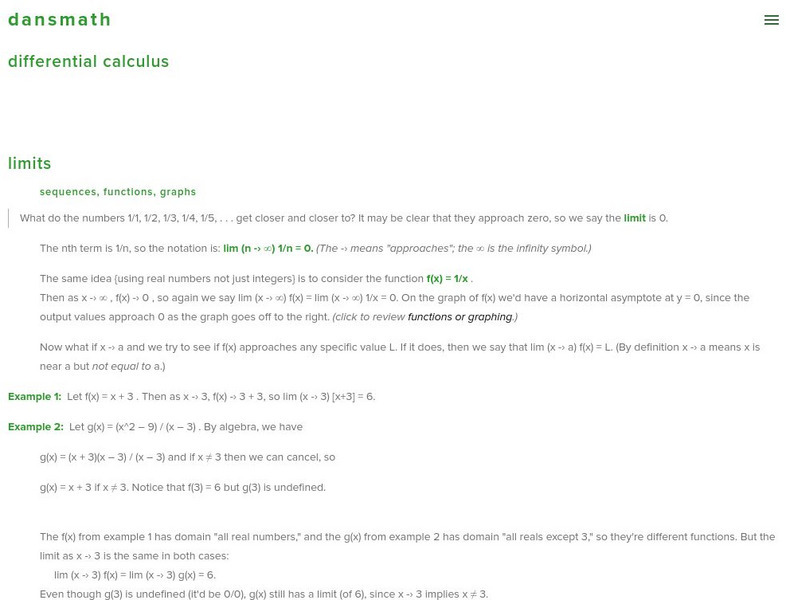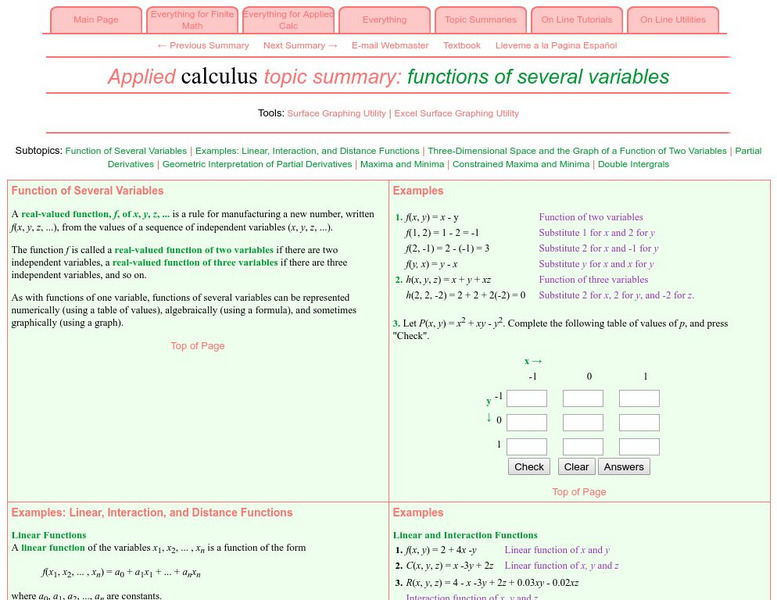Texas Instruments
Texas Instruments: The Growth Rings of a Tree
In this activity, the students can use limits to find derivatives and to find the relationship between radii and area. This activity uses tree growth as the basis for the activity.
Texas Instruments
Texas Instruments: Use of Cas in Teaching Differential Calculus by First Princip
This Computer Algebra System (CAS) activity encourages students to investigate the use of CAS to solve functions using derivatives and appropriate formulas.
Texas Instruments
Texas Instruments: Making Motion Graphs With Toys
Intended for the beginning lessons in derivative and function graphs, this activity uses motion detectors and battery operated toy cars to generate constant velocity graphs on a TI-83/84. Then students take a free-wheeling car and roll...
Other
Taro: An Application of the Derivative
This is a somewhat lengthy site discussing applications of the derivative using a trajectory problem as a template for understanding the concept. The page begins by defining a quadratic equation given three distinct points and then...
Texas Instruments
Texas Instruments: Exploring Derivatives Using Lists
This lesson will discover the power rule, and find the formulas for such functions as ln(x),e^x, etc. It uses lists and regression formulas.
Interactive Mathematics
Interactive Mathematics: Instantaneous Rate of Change
The derivative is applied to real world applications of velocity in an example using "h" notation and limits.
Interactive Mathematics
Interactive Mathematics: More on Curve Sketching
Examples are presented to demonstrate the steps for sketching curves that are not polynomials. Using x- and y-intercepts, limits, domain and range, maxima and minima, second derivatives and general behavior the graphs are constructed...
Interactive Mathematics
Interactive Mathematics: Tangents and Normals
Finding the slopes and equations of the tangent and normal lines of curves is demonstrated using derivatives. Interactive examples are provided.
Other
Metal: Differentiation [Pdf]
The resource is a lesson guide that teaches how differentiation applies in mathematical economics. Topics include differentiation, elasticity applications, and optimization applications. PowerPoint slides are included on how to deliver...
American Association of Physics Teachers
Com Padre Digital Library: Open Source Physics: Scalar Field Gradient Model
Students investigate scalar and vector fields though a downloadable java simulation. The simulation explores the gradient of a scalar field using a numerical approximation to the partial derivatives.
University of California
University of California: Maximum/minimum Problems
The following problems are maximum/minimum optimization problems. They illustrate one of the most important applications of the first derivative.
Interactive Mathematics
Interactive Mathematics: Differentiation
Explore the world of Calculus through differentiation. Focusing on areas such as limits, tangents to curves, and derivatives, this site shows you how to solve problems based on the discoveries of Sir Isaac Newton and Gottfried Leibniz....
Department of Defense
Do Dea: Marginal Cost, Marginal Revenue
Business applications of derivatives are widely used. Marginal revenue, cost, and profit functions that you can find by taking the respective derivatives of revenue, cost, or profit would provide very valuable information to a business....
Department of Defense
Do Dea: Optimization the Basics
In this lesson, you learn how to apply the concepts of maxima and minima to any formula that is generated by business, economics, physics, etc. It is one of the most important applications of derivatives and will show up on your AP...
Ministry of Education and Universities of the Region of Murcia (Spain)
Ministerio De Educacion Y Ciencia: Derivadas. Aplicaciones. Optimizacion.
In Spanish. This interactive unit is intended to show you how to calculate the derivative of a function and the application of the derivative in other sciences.
Texas Instruments
Texas Instruments: Graphing Relationships
In this activity, students explore information about a graph based on the first and second derivatives. They learn that a function's derivative is positive when the function increases and negative when the function decreases. They learn...
Texas Instruments
Texas Instruments: General Quadratics, Cubics, and Quartics
This activity explores the characteristics of the graphs of quadratic, cubic, and quartic functions. The graphing calculator will be used to generate graphs and derivatives of these functions.
Texas Instruments
Texas Instruments: Hairpin Curves
This activity uses derivatives to determine whether a vehicle of a certain length can traverse sharp curves on a trip up a mountain.
Texas Instruments
Texas Instruments: Optimization
This activity illustrates how the derivative is used to find a solution to an optimization problem.
Other
Dans Math: Lessons: Calculus (Part 1)
College professor Dan Bach reviews the basic calculus concepts of limits and derivatives. The site includes examples and animated graphs.
Stefan Warner and Steven R. Costenoble
Finite Mathematics & Applied Calculus: Topic Summaries: Functions of Several Variables
The topic summary outlines functions of several variables. Some topics reviewed are partial derivatives, double integrals, real-valued function, and three-dimensional space. The resource consists of definitions, notes, and examples.
Wolfram Research
Wolfram Science World: Cl Circuit
Shows how simple harmonic motion is used in a circuit comprised of an inductor and a capacitor. Includes detailed formula derivation utilizing calculus.
Texas Instruments
Texas Instruments: Hot Coffee
This activity is an application of differential equations and slope fields. Students first go through the traditional paper and pencil method of solving a differential equation. (Continued. See "before the activity.")
Texas Instruments
Texas Instruments: Zeros of a Cubic
This activity involves some of the prerequisites of calculus relating to functions and equations. It also contains an application of differentiation. (Continued. See "before the activity.")


